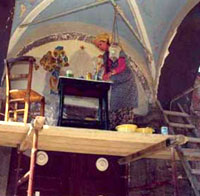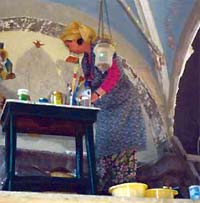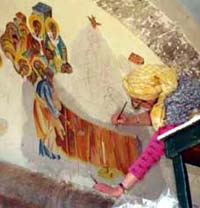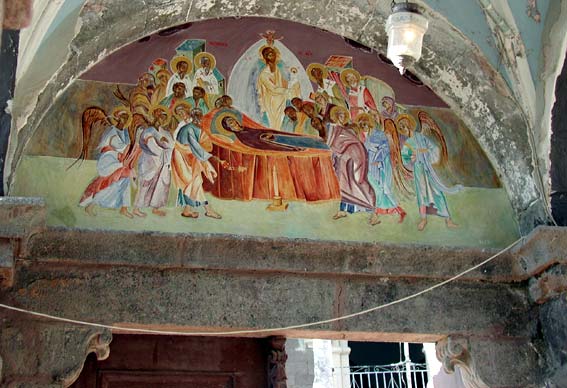 |
On our last trip to Mytilene to visit the town of Vatoussa, villagers enthusiastically pointed out the Byzantine-style fresco of artist Ann Welch beneath the dome of the town's bell tower. A vivid work-in-progress, the icon had had deeply moved us, particularly, since the artist was a foreigner and, most of all, a woman.
Nonetheless, as we stopped to admire her work, we could discern a sense of village pride among the narrative of our Greek friend. Vatoussans appreciated her attempt to recreate an authentic fresco, using traditional, time-consuming techniques, the first time in many centuries on the entire island. The fact that Ann was a woman only drew occasional comments, even though men -- typically clergymen -- have produced icons. But Ann is longtime summer resident whose masterful, acclaimed works in a variety of media have graced the local museum's walls and exhibition halls throughout Europe and the U.S. And, as we gazed at the brightly-colored figures of the icon, we marveled not only at the progressiveness of the village elders in welcoming this magnificent fresco, but also in the willingness of an English painter to offer such a gift to the village.
The work would take weeks, if not months to complete. Central figures were beginning to take shape and color, but, as the artist herself later explained, the process would require repeated wetting, painting, and drying of the same images. The images of frescoes could only be created one section at a time. In between the individual layers, the surface would have to be thoroughly dried and the bell tower kept free of water leaks which could destroy the fresco. During this laborious process, the final product is dependent upon temperature and humidity, as well as viscosity of paint and pressure of the paintbrushes. And there is no margin for error: once painted, the color must remain without alterations.
It was a learning process for the villagers, Ann elaborated, because she had had to explain a number of times that they had to repair the leaks in the tower so that the fresco would not be damaged while it was being completed or even after finished. And in a small Greek village where time—and efforts--could move slowly, it was a challenge for her to impress upon the men the necessity for repairing the tower leaks immediately.
Nevertheless, we admired her patient tenacity and resolved to stop periodically beneath the tower to mark her progress. There she would be, perched atop scaffolding to reach the lofty heights of the semicircular area. Wearing a colorfully smudged painting smock and waving paintbrushes in the air as she spoke, she would point out her current work area. We could see the Dormition of the Virgin Mary (Koismisis tis Theotokou) begin to take shape, selected in honor of the church just beyond the belltower, Koimisis tis Theotokou. Brilliant blues, golds, and reds were marking the shapes of the figures. And we could just barely discern the light outlines of other figures waiting to come alive with bright hues. Completed areas had the appearance of foreshortened Byzantine imagery. The bodies of the figures began to vanish under drapery, while the proportional sizes of facial features and hands increased slightly to reflect the underlying Byzantine theology behind the altered representations.
The finished icon would be a great source of pride for this
 |
village. Of that we were certain. Officially designated an historic village by the Greek government, Vatoussa has taken great pains to honor its architectural and cultural heritage. Streets are paved with large, shaped stones, just as in centuries past. Houses retain their distinctive village appearance: whitewashed or lightly-colored stucco-and-stone exteriors; brightly painted shutters—often green—frame windows; intricate fretwork often marks courtyard entryways. Narrow, sloping streets wind their way sinuously to the top of the hill, to the topmost quarter of the village behind which a sylvan forest provides shady respite and cool breezes for the entire village. Several large country mansions, "archontika spitia," punctuate the streets, one of which has been turned into a museum. This majestic structure, formerly the Gogos Mansion, now houses many items of local history and culture. Not only are there historic photographs and exhibits of vintage agricultural implements, but visitors may view art exhibits on the second floor. It is here that Ann Welch has shown many of her paintings about local culture and lore, in a number of media, depicting a range of subjects from local villagers to replicas of the Saints in Byzantine icons. But she prefers, as she tells us, to use natural subjects and settings, drawing heavily upon her countryside surroundings in Vatoussa. With a smile she adds that fellow villagers and friends never fail to identify the familiar scenes and live models of Vatoussa.
 |
Ann's work is recognized internationally. Although she is perhaps best known for her work in batik, her exhibitions of watercolors, oils, and other media have received acclaimed reviews from her colleagues. She studied batik in India and Indonesia, learning from the best masters there; her works in batik have been the subjects of a number of books and exclusive showings throughout the world. Ann has studied at the Pratt Institute, Parsons School of Design, the School of Visual Arts in New York, The School of Sacred Art at New York University, and at the Accademia Caerite in Rome. Moreover, Ann has worked with a number of renowned masters, among them iconographers Kostas Skordelis, Vladislav Andreyev, and Rev. Dimitri Economou, and Barbara Meise (Byzantine art techniques). With Nick Tidman and Nicholas Buhalis she has studied oil painting. In the U.S., Ann's work has appeared at the Cooper-Hewitt Museum, the Donnell Library in New York, and the Bellevue Art Museum in Seattle, as well as numerous other well known galleries and cultural centers in Cleveland, Chicago, Denver, Sante Fe, and San Francisco.
The inspiring works of Ann Welch have helped to capture for posterity a visual encomium of Vatoussa. In return, Vatoussans have responded with support and enthusiasm, proudly considering her one of the celebrities of the village. For Ann and her husband, Andrew Wengraf, a professor of philosophy, and their son, the village has become like a second home. Vatoussa beckons to them yearly as spring comes, heralding the arrival of another year and another season to be spent in a charming, traditional island village.
More about Ann Welch: English  Greek Greek
|





